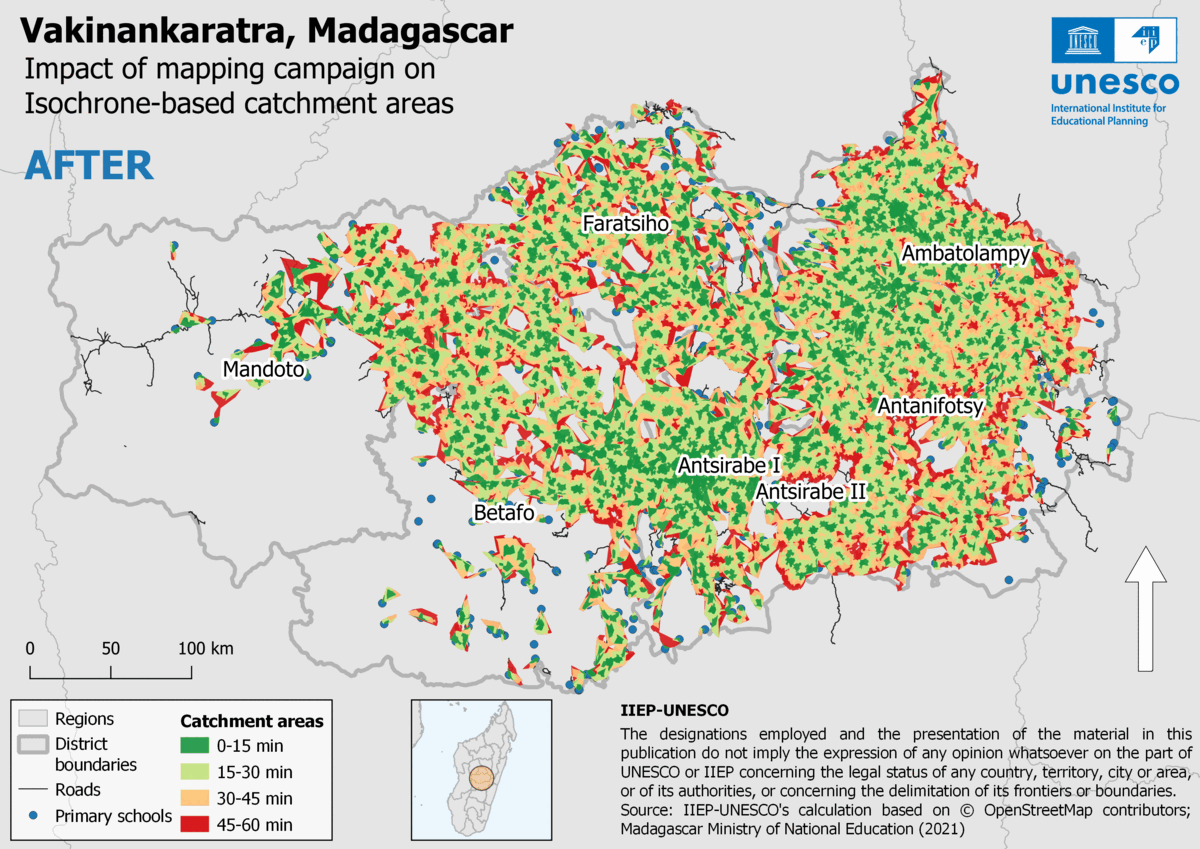2021/11/30-2021/12/06

聯合國圖客的影響 – IIEP 教科文組織與馬達加斯加教育部的繪圖活動 [1] | © IIEP 教科文組織與馬達加斯加教育部 | 地圖資料 © OpenStreetMap 貢獻者
大事件
- 在12月12日的 OSMF 會員大會上,主席 Allan Mustard 宣佈了理事會的選舉結果。Guillaume Rischard、Amanda McCann 與 Mikel Maron 再次當選。Roland Olbricht 作為新成員加入他們。共投出 742 張選票。也提供了詳細結果。
每週練習
- [1] 聯合國圖客 – IIEP 教科文組織地圖活動與馬達加斯加教育部合作,匯集了近 900 名志願者以推進教育規劃:在馬達加斯加的瓦基南卡拉特拉地區周圍繪製了 9,845 公里的道路地圖。現在 97% 的學校都連結到了路網資料,而專案開始時只有一半以上。生成的路網使用 IIIEP-UNESCO 學校捕捉外掛程式進行處理,以評估兒童每天從家到學校的旅行時間,並設計更好的干預措施。
畫地圖
- darkonus 發佈了解釋如何在使用 Apple Silicon 的 Mac 上安裝 JOSM 的說明。
- Forteller 分享了騎自行車勘查,然後在奧斯陸繪製一百多個公園地圖的冒險經歷,這為發現新地方提供了機會。
- 以下提案正在徵求評論:
amenity=library_dropoff用於繪製圖書館讀者可以歸還圖書館書籍或其他館藏的地方,且在圖書館之外。ele=*允許使用任何有紀錄的高度單位來標記高程。
社群
- OpenMapChile 回報了他們在城市樹木繪製方面的進展,特別是在瓦爾迪維亞市,他們在那裡總共新增了 15,062 棵樹。
- OpenStreetMap 比利時12月的當月圖客是來自俄羅斯的 d1sr4n。
- TechnicallyNotDeaf 是來自澳洲維多利亞州的新手貢獻者,他們以日記的形式分享了他們第一週繪圖的經驗。
- 使用者 pedr0faria 是第二屆聯合國繪圖松比賽的獲勝者,該活動由聯合國圖客組織,旨在透過在 OpenStreetMap 上繪製地圖為聯合國專案做出貢獻。
開放街圖基金會
- Michael Spreng 為成員工作小組撰寫的文章指出,有鑑於現在是選舉季,通常會有大量郵件寄到郵件清單中,他們試圖讓它冷靜下來。「我們 (MWG) 將限制參與者每天僅能寄送一封郵件到該清單(即 osmf-talk)。」
OSM 研究
- 一篇科學文章討論了
>
製圖對真實與虛擬的貢獻,包含繪圖松的案例,它讓人們能夠真實地呈現除 OSM 之外的其他地圖中失蹤的人。
地圖
- Yves 指出,已將 OpenSnowMap 網站剩餘的遺失功能新增至行動裝置版本中,是時候停用舊版本了。若您感到迷茫,您仍然可以從選單選項「LEGACY OPENSNOWMAP.ORG」中找到舊版本(至少一段時間內)。
開放資料
- Michael Cieslik 展示了如何使用開放式高程剖面資料將建築物高度與 OSM 資料的 LOD2 樣式 3D 彩現進行比較。Michael 的推文中的討論集中在資料集的差異與潛在的同步方式上。
軟體
- 在討論軟體治理的話題時,Roland Olbricht 指出 Overpass API 的巴士係數很低。mmd 補充
>
他們分支的存在並不一定會增加巴士係數,除了開發者數量之外的因素可以協助專案長期生存。
- OSM 歡迎工具背後的開發團隊最近開啟了對新區域的支援請求(說明可在該工具的 wiki 頁面上找到),並正在尋求新使用者的回饋。
- Robhubi 解釋了
>
他們用來從 GIP 匯入資料以與 OSM 進行比較的工作流程。圖形整合平台 (GIP) 是奧地利用於蒐集與分享運輸路線資訊的線上系統。
- 俄羅斯網際網路公司 VK(俄羅斯版 Facebook,前 MailRu 集團)部署了 Overpass Turbo 網站。他們也發佈了如何使用它的教學。
其他地理事情
- Anonymaps 告訴我們為 Google 工作但沒有薪水的令人興奮的機會。
- 布加勒斯特法院確認了 DIICOT (Direcţia de Investigare a Infraţiunilor decriminalitate Organizată şi Terorism Romano) 首席檢察官的決定,即在羅馬尼亞宗主教區根據地點和名稱提起刑事訴訟的案件中重新開始刑事調查 Google 地圖上的「救世主大教堂」(Cathedral of the Salvation of the Nation) 改成了「廢話大教堂」(Cathedral of Nonsense)。
- 海德堡大學地理資訊學系正在徵求一名兼職研究助理 (m, f, d),以在 GeCO 專案的背景下開發使用空間資料科學和機器學習(尤其是深度學習)方法生成空間高解析度二氧化碳排放清單的方法。
- Google 墨西哥提出了一個群眾外包專案,用於繪製佔該國總企業 50% 的各種街頭攤位的地圖。這些企業在地圖上不可見,Google 墨西哥從一名自由資料分析師準備的自訂地圖中注意到了這種情況。
未來活動
註: 你也可以在這裡展示你發起的活動!只須在行事曆上塡妥活動資訊即可。 只有記載於行事曆上的活動資訊才會在《週刊OSM》列出。你也可以在行事曆預覽檢查你提交的活動, 並作出適當更正。
這期 weeklyOSM 由 Supaplex, TheSwavu, derFred, s8321414 編譯 ##team##